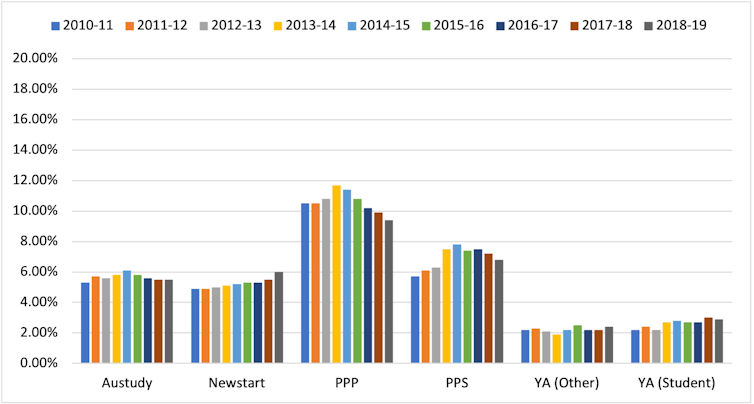The practice of “income averaging” to calculate debts in the robodebt scheme was completely flawed. This is what I confirmed in my new report conducted for the robodebt royal commission published on March 10, the final day of the commission’s public hearings.
This process effectively assumed many people receiving social security benefits had stable earnings throughout a whole year.
But this is unlikely to be accurate for the many people who don’t work standard full-time hours, and particularly for students, since the tax year and the academic year don’t coincide.
My report finds averaging of incomes is completely inconsistent with social security policies that have been developed by governments since the 1980s.
Since 1980, social security legislation has been amended more than 20 times to encourage recipients to take up part-time and casual work. These include the Working Credit for people receiving unemployment and other payments, and a similar but more generous Income Bank for students.
These measures are specifically designed to encourage people to take up more work, including part-time and irregular casual work, and keep more of their social security payments.
Robodebt’s lack of consistency with long-standing policies should have been obvious from the start.
What is income averaging?
In the robodebt scheme, income averaging involved data-matching historic records of social security benefit payments with past income tax returns, identifying discrepancies between these records.
It reduced human investigation of the discrepancies. The automatic calculation of “overpayments” for many people was based on a simple calculation that averaged income over the financial year.
The “debts” were based on the difference between this averaged income and the income that people actually reported while they were receiving payments.
I wrote an article for The Conversation on this in 2017. At the time, I thought, Centrelink couldn’t possibly have done that.
Well, as the royal commission has found, that’s precisely what it was doing.
A victim of robodebt, Deanna Amato, brought a test case to the Federal Court in 2019, which caused the government to admit robodebt was unlawful.
Amato also gave evidence at the royal commission in late February this year. She described how it was obvious her debt was in error:
It was averaged over the […] whole financial year. Study usually starts at the beginning of a calendar year. So I had been working full-time for the first six months of that year and then I had stopped working full-time to study. So it was really obvious that they had averaged out over the whole year rather than the six months I was actually only claiming Austudy for.
What I found
It’s well known Australia has a high proportion of casual workers.
Because they’re employed on an “as needed” basis, their hours can vary substantially. Therefore, their income can too.
ABS data showed that in 2014 nearly 40% of casual workers didn’t work the same hours each week. Also, around 53% had pay that varied from one pay period to another. These figures have been broadly stable since 2008.
My report analyses new data provided by the Department of Social Services to the royal commission. It looks in detail at the circumstances of people who received social security payments between 2010-11 and 2018-19. These payments included Austudy, Newstart, Parenting Payment Partnered, Parenting Payment Single and Youth Allowance.
These payments accounted for around 91% of the people subject to the reviews that identified discrepancies and potential “overpayments” between 2016 and 2019 under the different phases of robodebt.
For Newstart and Youth Allowance recipients – who accounted for 75% of those affected by robodebt – between 20% and 40% had earnings while receiving these benefits.
The share of people with income who had stable incomes over the course of the financial year was extremely low. In the Department of Social Services data, it ranged from less than 3% of people receiving youth payments, to around 5% of those receiving Newstart or Austudy, and 5%-10% of those receiving Parenting Payments.
Share of people on social security payments with stable income over the course of each financial year, 2010-11 to 2018-19

Supplied, Author provided
For most of these people with variable income, the variations were large. More than 90% had periods when their income was more than $100 per fortnight different from their average, and more than 80% had variations greater than $200 per fortnight.
Average earnings varied substantially for people receiving social security payments for only part of a financial year. Receiving social security benefits for many people is a short-term and sometimes recurring experience.
To take the example of Newstart, in 2015-16 there were around 783,000 people who received payments at the start of the financial year. About 500,000 people entered the payment system during the year, and 325,000 exited the system. So, in total, nearly 1.2 million people received Newstart payments at some point during the financial year. Flows into and out of the other social security payments were similar.
For the unemployed and students, most people received payments for only part of the year. Almost nobody who received income had completely stable income over the robodebt period. What’s more, significant numbers of people who received social security payments were on such payments for only part of any financial year.
It’s completely inaccurate to assume that income over the course of a financial year can be averaged to produce an accurate figure for the actual patterns of people’s earnings.
Using this to then calculate “overpayments” isn’t only inconsistent with the social security policy directions adopted by government for decades, it also lacks basic common sense.![]()
This article is republished from The Conversation under a Creative Commons license. Read the original article.





I was Senior Adviser on Taxation and Income Security in the Department of Prime Minister and Cabinet years ago. I assumed income averaging was a computer programmer’s mistake. It takes less than 15 minutes looking at the legislation to realise the legal period for ascertaining entitlement is fortnightly, so annual averaging could never be right. After all, if one had to wait a year to determine entitlement, one might starve to death first.
You state: “After all, if one had to wait a year to determine entitlement, one might starve to death first”. Except: this is EXACTLY how ‘Family Tax Benefit’ works right now (i.e. entitlement is worked out retrospectively on an annual, financial year, basis, & is only knowable once a financial year has ended – ‘instalment entitlement claimants’ estimate their ATI for a current financial year, ‘anticipating’ an entitlement for that year that can’t be known until AFTER that financial year has ended). For many, if not most, FTB ‘instalment entitlement claimants’ who have variable earnings during a financial year, an annual financial year basis of entitlement leads to both over AND under payment of FTB (& is a counter-intuitive entitlement basis for payments that, when paid to families with low or no private income, constitute, effectively, ‘income support for children’; I mean, as you pointed out Dr Dwyer, we don’t use such an entitlement basis for adult income support, do we?).
A very nice comment. The answer lies in history and the unwise abolition of so-called concessional deductions for children which were replaced by eventually means tested family payments. Under the deduction system PAYG withholding fortnightly reflected the child deductions. All a classic case of “reform” proceeding to create inequity and inefficiency via incremental piecemeal steps.